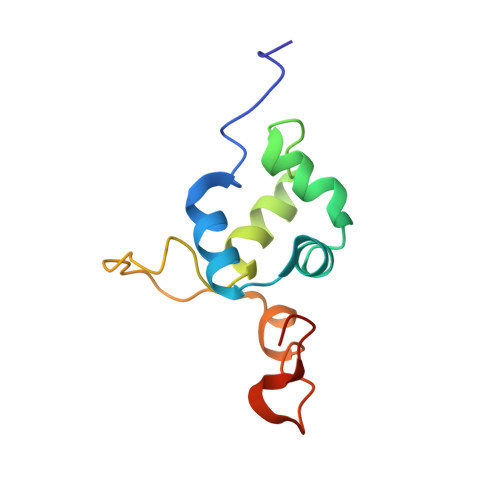Archaeal MBF1 binds to 30S and 70S ribosomes via its helix-turn-helix domain.
Blombach, F., Launay, H., Snijders, A.P., Zorraquino, V., Wu, H., de Koning, B., Brouns, S.J., Ettema, T.J., Camilloni, C., Cavalli, A., Vendruscolo, M., Dickman, M.J., Cabrita, L.D., La Teana, A., Benelli, D., Londei, P., Christodoulou, J., van der Oost, J.(2014) Biochem J 462: 373-384
- PubMed: 24825021
- DOI: https://doi.org/10.1042/BJ20131474
- Primary Citation of Related Structures:
2MEZ - PubMed Abstract:
MBF1 (multi-protein bridging factor 1) is a protein containing a conserved HTH (helix-turn-helix) domain in both eukaryotes and archaea. Eukaryotic MBF1 has been reported to function as a transcriptional co-activator that physically bridges transcription regulators with the core transcription initiation machinery of RNA polymerase II. In addition, MBF1 has been found to be associated with polyadenylated mRNA in yeast as well as in mammalian cells. aMBF1 (archaeal MBF1) is very well conserved among most archaeal lineages; however, its function has so far remained elusive. To address this, we have conducted a molecular characterization of this aMBF1. Affinity purification of interacting proteins indicates that aMBF1 binds to ribosomal subunits. On sucrose density gradients, aMBF1 co-fractionates with free 30S ribosomal subunits as well as with 70S ribosomes engaged in translation. Binding of aMBF1 to ribosomes does not inhibit translation. Using NMR spectroscopy, we show that aMBF1 contains a long intrinsically disordered linker connecting the predicted N-terminal zinc-ribbon domain with the C-terminal HTH domain. The HTH domain, which is conserved in all archaeal and eukaryotic MBF1 homologues, is directly involved in the association of aMBF1 with ribosomes. The disordered linker of the ribosome-bound aMBF1 provides the N-terminal domain with high flexibility in the aMBF1-ribosome complex. Overall, our findings suggest a role for aMBF1 in the archaeal translation process.
Organizational Affiliation:
*Laboratory of Microbiology, Wageningen University, Wageningen 6703HB, The Netherlands.














